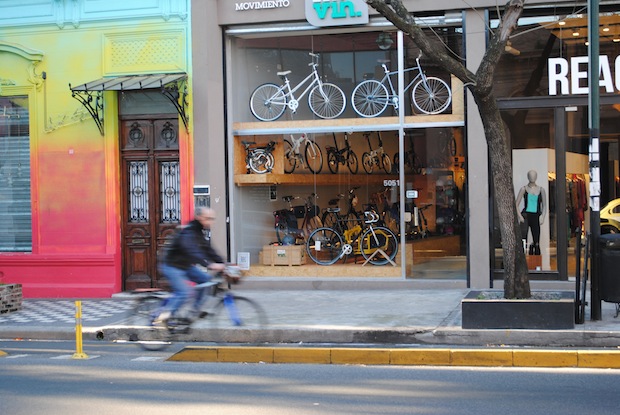The upside of Buenos Aires' bike lanes? The boon to business


BUENOS AIRES -- In the 2011 mayoral election in Buenos Aires, opposition candidate Daniel Filmus said that many of the city's new bike lanes, "would have to be removed," and that bike lanes, "would not be the principal [transportation] strategy," if he won. The government headed by the mayor at the time, Mauricio Macri, had built 65 kilometers of the paths and, six months before the election, had launched a free bike share scheme. The jury was still out on the bike lanes (locals were only taking an estimated 36,000 bike trips a day), and if given the chance any taxi driver would happily rant about how they ruined the city.
Today, it's unlikely that a mayoral candidate would suggest ripping out the lanes (Macri won re-election). Buenos Aires now has 100 kilometers of bike lanes, and the city government estimates that locals take some 150,000 bicycle trips daily. While Buenos Aires isn't a bicycle paradise like Amsterdam, it's nearly impossible not to notice the bicycle boom. It's pretty common to see pedestrian/bike crashes as well, as locals are still learning to pay attention.
"Today, riding a bike in Buenos Aires is cool. Two years ago, it wasn't," Mati Kalwill says. Kalwill is founder of La Vida en Bici and Bikestorming, two local pro-bicycling civic start-ups. "Before, no one rode a bike because it was the transport for someone who couldn't even afford a moped. Now it's like you're posh if you ride one."
Besides the obvious transit and health advantages, the city has seen other, less obvious, benefits. A rash of businesses catering to the cycling boom have popped up on or near the new bike lanes. As we've noted here on SmartPlanet, studies have shown that, improving bike transit helps businesses near bike routes. Between 2004 and 2010, Portland installed 40 bicycle corrals (parking zones), and by the time of a 2012 Portland State University study, businesses within half a block said that a quarter of their customers were bicyclists. Another 2008 study by Alta Planning + Design found that the value of the bike-related industry to Portland’s economy had grown nearly 40 percent since 2006, to almost $90 million. Other studies point in the same direction.
"What is interesting is to think of the bicycle as a catalyst for business opportunities," Kalwill says. "When a guy in a car wants to buy something at a corner store, he often can't because he can't find a parking space. So he goes to a big mall. But a guy who comes on a bike, he stops around the corner, buys what he needs, and goes home. It's all about the local economy."
While it is impossible to measure the exact economic impact of the Buenos Aires system because it is so new, anecdotal evidence shows that it is having an effect. The most obvious examples are in well-touristed neighborhoods like Palermo, where high-end bike shops and rental agencies have opened along the new lanes. Cristian Martinelli, a 34-year-old physical education teacher, had long dreamed of opening a bike shop when the city began building the lanes. When a store came up for rent alongside a bike path on a Palermo street named after Jorge Luis Borges, Martinelli pounced.
"It's the moment. I had visualized how I wanted the store, and when the whole bike lane thing started, it was like, 'It also has to be on a bike lane.' The growth from the lanes is the best thing that can happen to people who like bikes. And it's beginning to interest those who don't like them," Martinelli says, standing behind a row of white rentals outside Moving Bike, which he opened in April.
Today, his store rents a half dozen bikes per day (about $4.75/hour or $19/day), in addition to selling accessories and repairing bikes. He says that the renters are mostly foreigners -- especially Brazilians -- who've grown accustomed to travelling by bike from visits to cities like Barcelona, Paris and Amsterdam, where it is common.
Similarly, bike accessory design firms have popped up to take advantage of the increasing number of stylish locals tooling about the city. After launching a design firm in France that sold bicycle-related gear, 30-year-old textile designer Tamara Rachi returned to Argentina and a year ago co-founded Hélice, which sells high-design saddle bags and the like (prices around 400 pesos, or $75).
"The fact that there are bike lanes clearly pushes more people to use bicycles as their daily means of transit," Rachi says.
The company sells locally and exports as well, to Norway, a practice that the city is trying to promote. In this year's Puro Diseño design show, the city added a stand featuring bicycle-related products; 30 recently founded businesses applied and 12 were accepted, including Hélice.
Not surprisingly, businesses completely unrelated to biking have tried to jump on the bandwagon. Cafés on and near the bike lanes have begun to offer discounts to bikers as a way of turning them into long-term customers. When Andrés Cano, co-founder of the Almacén Purista café, came across La Vida en Bici, a website that maps South American cities for cyclists, he and his partners decided to offer cyclists a special free coffee made with condensed milk. According to Cano, 28, they serve three to five a week, an investment that quickly pays itself back.
"In the majority of the cases, the cyclist who gets the coffee comes back various times, he talks about it, he returns with friends," Cano says. "The economic benefit is thanks to the word of mouth it generates, it brings in new clients. Truth is, it's had a really good effect."
Photos from Ian Mount, Hélice, Almacén Purista
This post was originally published on Smartplanet.com